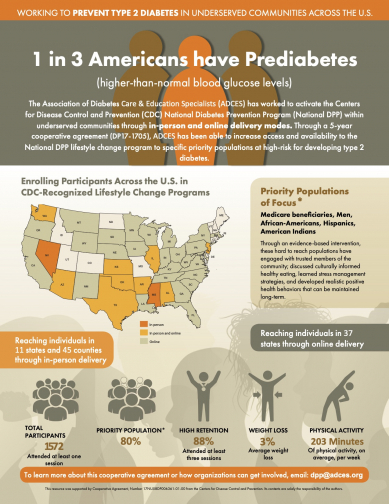About the National Diabetes Prevention Program
About the National Diabetes Prevention Program
Did you know?:
- One in three Americans—over 88 million adults—has prediabetes.
- More than 8 in 10 don’t even know they have it.
- Without treatment, many people with prediabetes develop type 2 diabetes within five years.
Fortunately, there’s a program dedicated to preventing and delaying the onset of type 2 diabetes by helping people eat healthy, move more and build other healthy habits that last a lifetime. This program, called the National Diabetes Prevention Program (DPP), is led by the Centers for Disease Control and Prevention (CDC.)
The National DPP started with a clinical trial in 1996 called the Diabetes Prevention Program Study. This study investigated whether modest weight loss achieved through healthy eating and being active worked better than medication to reduce the risk of developing type 2 diabetes. Four years into the study, they learned that a structured lifestyle program can reduce the risk of developing diabetes in high-risk patients by 58 percent; 71 percent for people over 60 years old! Inspired by these results, Congress authorized the CDC to make this lifestyle change program widely available across the country. As CDC started to expand the National DPP to YMCAs, hospitals and health centers, workplaces and houses of worship, they continued to follow up with the people who completed the program back in the 1990s. A recent study showed that after more than 20 years, people with prediabetes who made these healthy changes continued to reduce their risk of developing type 2 diabetes.
What Lifestyle Changes Are Included in the National DPP?
The lifestyle change program includes:
- A CDC-approved curriculum with resources, handouts and tips to help you make healthy changes to eat healthily, get active, manage stress and monitor your health.
- A lifestyle coach who can help you learn new skills, encourage you to set and meet goals and keep you motivated.
- A supportive group that can share ideas, celebrate successes and brainstorm how to tackle challenges.
If you decide to go through the program, you have to commit for one year which is about 24 hours of your life over 365 days!
- During the first six months of the program, you will meet with your coach and group about once a week.
- During the second six months, you’ll meet with them once or twice a month.
Interested in the curriculum for the PreventT2 program? Download it from the CDC website here.
ADCES’ Work in Diabetes Prevention
For the last eight years, Association of Diabetes Care & Education Specialists (ADCES) has been committed to expand the National DPP and provide support to those most at risk of developing type 2 diabetes. ADCES’ goal is to enroll at least 5,000 people by September 2022 through in-person, telehealth and online programs. ADCES is reaching out to:
- Rural communities
- Latinx and Black/African American communities
- Medicare beneficiaries
- Native Americans
- People whose jobs put them at risk for type 2 diabetes like truck drivers and migrant and seasonal farmworkers
ADCES has a prevention newsletter to highlight their community partners doing this important work. The newsletter highlights ADCES’ efforts to engage road truckers, spotlights lifestyle coaches and other wellness champions who are making a difference in their communities, and celebrates National DPP participants who are living healthier lives.
Are You Eligible to Participate in the National Diabetes Prevention Program?
Per CDC guidelines, in order to participate in the National DPP, you must meet all of the requirements:
- Be 18 years or older
- Be overweight (body mass index above 25, or 23 if you are Asian)
- Have not been diagnosed with type 1 or type 2 diabetes
- Not be pregnant
Additionally, you have to meet one of the following criteria:
- Have had a recent blood test in the prediabetes range, which includes one of the following tests and results:
- Hemoglobin A1C: 5.7–6.4 percent or
- Fasting plasma glucose: 5.5-6.9 mmol/L100–125 mg/dL or
- Two-hour plasma glucose (after a 75 gm glucose load): 7.8-11.1 mmol/L140–199 mg/dL
- Have received a result of high risk for type 2 diabetes on the Prediabetes Risk Test.
- A doctor previously diagnosed you with gestational diabetes.
If you are enrolling in a program covered by Medicare, you MUST have had a recent blood test in the prediabetes range, which includes one of the following tests and results:
- Hemoglobin A1C: 5.7–6.4 percent or
- Fasting plasma glucose: 6.1-6.9 mmol/L110–125 mg/dL or
- Two-hour plasma glucose (after a 75 gm glucose load): 7.8-11.1 mmol/L140–199 mg/dL
How to Find a National DPP Class In Your Area
Currently, the National DPP is available throughout the country and U.S. territories. You can find one on the CDC website.
The cost of participating in a CDC-recognized lifestyle change program depends on the organization and if it’s conducted in-person, through telehealth, or online. Some employers and public and private insurance carriers, like Medicare and Medicaid, may cover the cost so please check with them to determine if they do.
This content is published in partnership with ADCES, a Founding Partner of Beyond Type 2.






